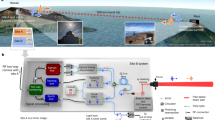Abstract
The T2L2 experiment allows the synchronisation of remote clocks on Earth, and the monitoring of a satellite clock with an accuracy in the 50 ps range. It is based on the propagation of light pulses in space which is better controlled than the radio waves propagation. Some new optical timer and the definition of a new time origin allow direct accurate time transfer without external calibration. The time equations and the uncertainty budget are presented so as to justify the announced performance. This optical time transfer associated to an ultra-stable clock in space has many scientific application as the study of some aspects of the gravitation.
Similar content being viewed by others
References
Fridelance P., Lexpirience LASSO,these de doctorat de physique de l'universite Paris 6,1994.
Fridelance P., Veillet C., Operation and data analysis in the LASSO experiment,Metrologia, 32, 27–33, 1995.
Veillet C., Fridelance P., Fraudy D., Boudon Y., Shelus P.J., Ricklefs R.L, Wiant J.R.: LASSO observations at Mc Donald (Texas, USA) and OCA/CERGA (Grasse, France). A preliminary analysis,Proc. 24 th Precise Time and Time Interval Meeting (PTII), Virginia, USA, pp. 113–120,1992.
Veillet C, Fridelance P.: Time transfer between USA and France through LASSO,Proc. 7 h Europeen Frequency and Time Forum (EFTF), Neuchftel, Suisse, pp. 6 37–640,1993.
Lewandowski W., Petit G., Beaumont F., Fridelance P., Gaignebet J., Grudler P., Veillet C., Wiant J.R., Klepczynski W.J.: Comparison of LASSO and GPS time transfers,Proc. 25 th PTTI Meeting, California, USA, pp. 357–365,1993
Lewandowski W., Thomas C., in proc. IEEE, 79, 991–1000,1991.
Kirchner D., Two-way satellite time transfer via communication satellites,in proc. IEEE, 79, 983–990, 1991.
Nau H., Hahn J., Bedricht S, Study on H-Maser in space,Draft final report, DLR Oberpfaffenhofen, Institute of Radio Frequency Technology, 1994.
Starker S., SappI E., Schafer W., Microwave links for precise time and frequency transfer betweencground and space-based clocks,in proc. 7 t k EFTF, 693–698, 1993.
Samain E. Le laser-Lune millimdtrique et Nouvelles mdthodes de datation optique,These de doctorat de l'Univeriste de Nice-Sophia Antipolis, 1995.
Petit G, Wolf P., Relativistic theory for picosecond time transfer in the vicinity of the Earth,Astronomy and Astrophysics, 286, 971–977,1994.
IAU, Information Bulletin 67,7,1992.
Samain E, Optical statistical timer,submitted to proc. IEEE, 1996.
Samain E., Mangin J.F., Detector studies for the millimetric Lunar-laser ranging,in proc. of the 9 t h international workshop on laser ranging instrumentation, 1994.
Bender P.L., Atmospheric refraction and satellite ranging,in proc. of the Symposium "Refraction of transatmospheric signals in geodesy ",117–125, 1992.
Allan D.W., Weiss M.A., Jespersen J.L., A frequency domain view of time domain characterisation of clocks and time and frequency distribution systems,45 e annual symposium on frequency control, 1991.
Laurent P., Santarelli G., Lea S., Ghezali S., Bahoura M., Simon E., Clairon A., Lemonde P., Reichel J., Michaud A., Salomon C., Cesium fountains and micro-gravity clocks,in proc. of the 25 th Rencontre de Moriond, ed. Frontieres, 1990.
Fridelance P. " Influence of the atmospheric turbulence on the uplink propagation in an optical time transfer ", submitted to Applied Optics, 1996.
Busca G., Bernier L.G., Silverstrin P., Feltham S., Gaygerov B.A., Tatarenkov V.M., in proc. of the 25 th FTMI meeting, 467–475, 1993.
Maleki L., Frequency standards from government laboratories over the next 25 years,in proc. of the 254 h PTTI meeting, 549–560, 1993.
Vessot R.F.C., Levine M.W., Test of relativistic gravitation with a space-borne hydrogen maser,Physical Review Letters 45, No. 26, 2081–2084, 1980f.
Will C.M., Gravitation redshift measurements as tests of non-metric theories of gravity,Phys. Rev. D., 10, 2330–2337, 1974.
Veillet C., SORT, Solar Orbit Relativity Test,A proposal in the discipline area of fundamental physics in response to ESA's call for mission concepts for the follow-up to horizon 2000, 1994.
Lebach D.E., Corey B.E., Shapiro I.I., Ratner M.I., Webber J.C., Rogers A.E.E., Davis J.L., Herring T.A., Measurement of the solar gravitational deflection of radio waves using very-long-baseline interferometry,Physical Review Letters, 75, No. 8, 1995.
Bergmann P.G., Comments on the scalar-tensor theory,Int. J. Theor. Phys., 1, 25–36, 1968.
Wagoner R.V., Scalar-tensor theory and gravitational waves,Phys. Rev., D1, 3209–3216, 1970.
Nordtvedt K., Post-Newtonian metric for a general class of scalar-tensor theories and observational consequences,Astrophys. J., 161, 1059–1067, 1970.
Author information
Authors and Affiliations
Rights and permissions
About this article
Cite this article
Fridelance, P., Samain, E. & Veillet, C. T2L2 - Time transfer by Laser link: a new optical time transfer generation. Experimental Astronomy 7, 191–207 (1997). https://doi.org/10.1023/A:1007982512087
Issue Date:
DOI: https://doi.org/10.1023/A:1007982512087




